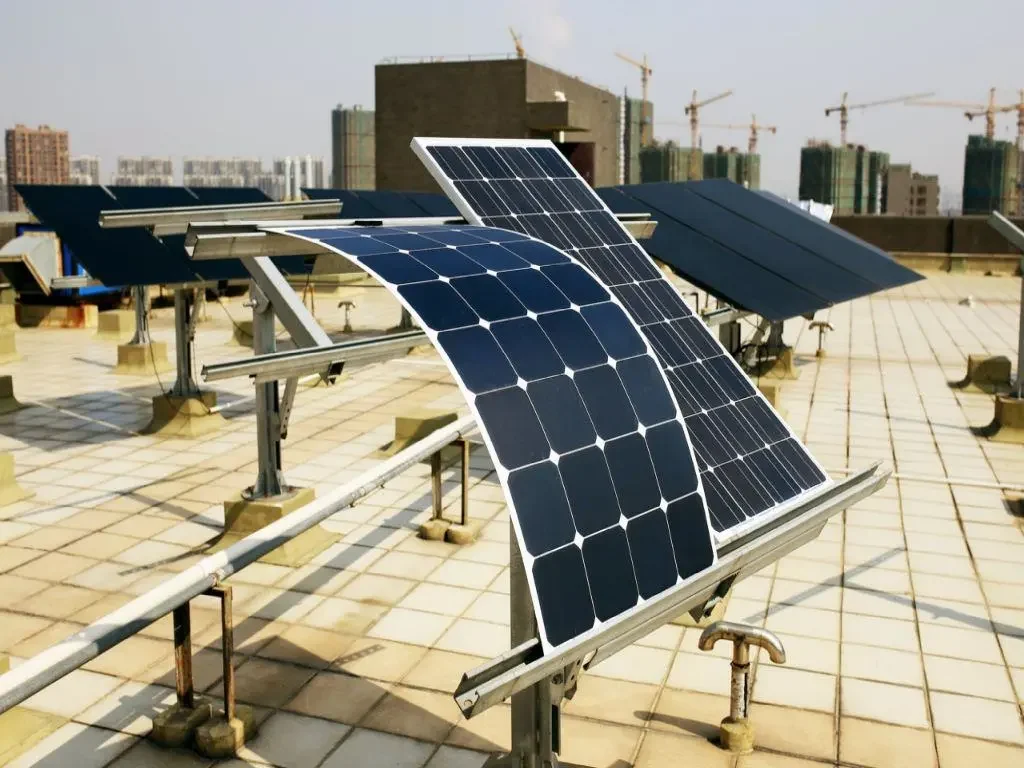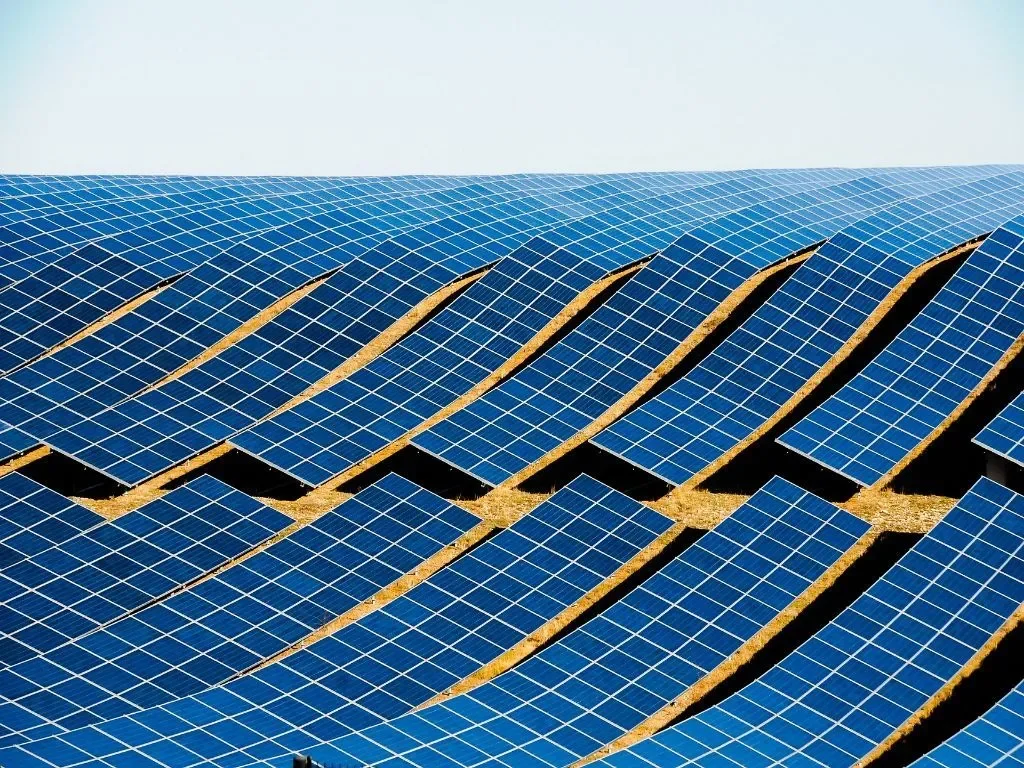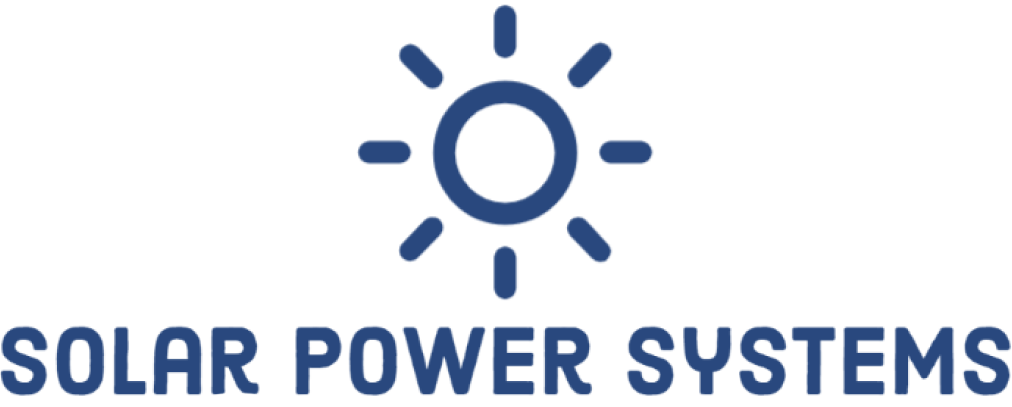Renewable energy sources have never been more urgently required as the international community continues to confront the consequences of climate change. Solar energy is notable for its abundance and sustainability among these alternatives. This article examines the efficacy of thin-film technology utilized in solar cells, a critical subset of solar energy technology.
Due to their potential for increased efficiency and decreased expense, thin-film solar panels, a relatively recent development in photovoltaic technology, have been sensational. The worldwide market for thin-film solar cells was assessed at $11.3 billion in 2020 and is anticipated to expand at a CAGR of 8.4% from 2020 to 2030, reaching $25.3 billion by 2030. The performance of these cells swiftly approaches that of conventional silicon-based cells, with efficiencies ranging from 6% to 8% for amorphous silicon cells and up to 23% for copper indium gallium selenide cells.

Source: Wikipedia
Nevertheless, doubt persists regarding the practical effectiveness of thin-film technology. Using recent research and empirical data, this article intends to provide a comprehensive analysis of this issue. Environmental conditions, material selection, and manufacturing processes are a few of the variables that will be investigated in relation to their impact on efficiency.
Beyond policymakers, investors, and consumers who are placing their trust in solar energy as a significant contributor to a sustainable future, this inquiry is of the utmost importance for scientists and engineers in the field. We can move forward with innovation and make well-informed judgments by comprehending the true capabilities and constraints of thin-film technology.
What Thin-Film Solar Panels Are and How They Are Made
The thin film solar cells, which are commonly used in residential solar panels, are a form of photovoltaic cell that converts solar energy into electrical energy. Substrate-deposited narrow semiconductor materials comprise their construction. These semiconductor layers comprise the “thin” in a thin film; each one is several times thinner than a human hair.

Source: Renewable Systems
The manufacturing algorithm for thin-film panels consists of the following steps:
- In the initial phase of thin-film solar cell fabrication, a thin layer of substrate material, which is typically glass, plastic, or metal, is deposited on a solid surface. This substrate functions as the foundation upon which additional components are deposited to form the solar cell.
- Substrate deposition of semiconductor materials constitutes the second stage. These substances, which may consist of silicon, cadmium telluride, copper indium gallium selenide, convert sunlight into electrical energy. The selection of semiconductors is determined by the requisite efficacy and the cost of solar panels.
- In the third stage, electrodes are affixed to both the upper and lower surfaces of the semiconductor material. By means of these electrodes, electric current can be conducted from the solar cell to an external circuit.
- The ultimate stage involves encapsulating the cell, which serves to safeguard it against environmental elements and prolong its viability.
Numerous householders contemplating the installation of solar panels on their properties have examined the efficacy of thin-film solar cells. Although these panels may not achieve the highest levels of efficiency, they do present a number of advantageous features.
Furthermore, the production cost of thin-film solar cells is significantly lower in comparison to that of conventional silicon cells. The combination of their adaptability and affordability has resulted in a consistent growth in their market presence. Nevertheless, it is critical to mention that the effectiveness of thin-film solar cells may differ contingent on the specific semiconductor material employed. The performance of the thin-film system is upon the PV material employed in the cells; however, on average, their efficiencies range from approximately 7% to 18%.
Although thin-film solar cells may not exhibit the utmost efficiency, their cost-effectiveness, adaptability, and ongoing progress in thin-film technology render them a feasible alternative for individuals seeking to harness solar power.
Types of Thin Film Solar Panels
The efficacy of thin-film technology is contingent upon the material composition, wherein amorphous silicon (a-Si), cadmium telluride (CdTe), and copper indium gallium selenide (CIGS) comprise the three primary varieties of thin-film panels.
Amorphous Silicon (a-Si) Photovoltaic (PV)
Amorphous silicon (a-Si) solar panels are constructed using a non-crystalline silicon material, enabling them to be adaptable and versatile. On average, a-Si panels have an efficacy of between 6 and 8 percent, which is lower than that of other varieties.
Cadmium Telluride (CdTe)
Cadmium telluride (CdTe) solar panels are the most economically viable option among photovoltaic solar panels. They can achieve an 18% efficacy rate, which is greater than that of a-Si panels. Their use of cadmium, a toxic heavy metal, does, however, give rise to environmental concerns.
Copper Indium Gallium Selenide (CIGS)
Copper Indium Gallium Selenide (CIGS) solar panels are the most efficient thin-film panels, achieving an efficiency of up to 23.35%. Nevertheless, production costs are elevated as a result of the intricacy associated with their solar panel material.

Source: EcoWatch
The material utilized in photovoltaic solar cells influences the efficiency of thin-film technology. Notwithstanding their diverse range of efficiencies, these panels are indispensable for the growth and variety of solar energy applications. It is anticipated that as technology advances, thin film solar panels will become more efficient, thereby increasing their feasibility as alternatives in the renewable energy industry.
Application Area of Thin-Film Solar Panels
Notwithstanding their potential applications and distinctive characteristics, thin-film solar cells have attracted considerable interest as a recent development in the field of solar energy. Thin film solar cells are functional on an extensive range of media due to their slender and flexible construction. The enhanced functionality and wider range of applications of these devices can be attributed to their lightweight construction and flexibility.

Source: The Eco Experts
- Residential: the incorporation of thin-film solar cells is a growing trend in residential applications. The solar industry in the United States increased capacity by 20% from the second quarter of 2022 to the second quarter of 2023 but decreased by 8% from the first quarter to 5.6 gigawatts-direct current (GWdc), according to a study by the Solar Energy Industries Association. Thin-film panels are a superior integration into the aesthetics of residences than conventional solar panels, and they are favored by some homeowners on account of their streamlined appearance.
- Commercial establishments: thin film technology is also being utilized to the advantage of commercial structures. Major installations of thin film solar cells are feasible for businesses due to the expansive roof space. This contributes to the reduction of carbon emissions from these establishments and results in significant energy savings.
- Building-integrated photovoltaics (BIPV): the integration of thin film solar cells into building materials, including facades and windows, constitutes building-integrated photovoltaics (BIPV). It contributes to the energy effectiveness of the structure by enabling it to produce its own electricity. According to a report by Grand View, the global market for building-integrated photovoltaics is projected to increase at a compound annual growth rate (CAGR) of 21.0% between 2023 and 2030, from $19.82 billion in 2022, according to research.
- Vehicles: research is being conducted on thin film solar cells for use in vehicles. To facilitate the battery recharging process of the Prius, Toyota, for example, has incorporated thin film solar cells onto the vehicle’s roof.
Thin film solar cells are a viable option for a vast array of applications due to their adaptationability and efficiency.
The Lifespan of Thin-Film Solar Panels
At a comparable duration to alternative solar technologies, thin-film solar panels are distinguished by their slender and lightweight construction. Their efficiency may, however, diminish with age, similar to everything else.
- Lifespan: with an average tenure of 10 to 20 years, thin film solar panels are constructed to last. But, the thin-film cell has the shortest operational life of the three categories of solar panels. The longevity of thin film technology is exemplified by their resilience.
- Effectiveness over time: over time, thin film panels, similar to other varieties of solar panels, undergo a decline in efficiency. Approximately 0.6% – 0.7% annual degradation has been observed in thin film solar panels, according to research.
- Comparison with other technologies: in contrast, conventional silicon-based solar panels exhibit a relatively accelerated degradation rate of approximately 0.8% annually. Therefore, it is possible that thin film solar panels could deliver a greater amount of energy throughout their operational lifespan.
- Environmental aspects: environmental factors can have an impact on the durability and effectiveness of thin film solar panels. For example, the rate of deterioration may be accelerated for panels that are installed in environments characterized by elevated temperatures or humidity levels.

Source: American Solar Energy Society
Substantially and effectively, thin-film solar technology provides an enduring solution for power harvesting. In the long term, they continue to outperform their alternatives, rendering them a valuable investment for sustainable energy generation, notwithstanding a marginal decline in efficiency attributed to degradation.
How the Efficiency of Thin-Film Solar Panels Varies With the Weather
Experts and prospective users are intrigued by the efficiency of thin-film solar panels, specifically in fluctuating weather conditions. The effect of meteorological conditions, such as high temperatures and precipitation, on the efficacy of thin-film solar panels is examined in this section.
The Influence of Weather
The efficiency of thin-film solar panels is substantially threatened by inclement weather. Unlike conventional solar panels, thin-film panels retain their efficiency even when confronted with cloudy conditions, owing to their ability to absorb diffused sunlight. Rainy weather, nevertheless, diminishes their effectiveness.
The Influence of Temperature
Further degradation of thin-film solar panels can occur due to elevated temperatures. Thin-film solar panels are more heat-resistant than conventional panels, their efficiency decreases with increasing temperature. Their efficacy exhibits a lesser decline in high temperatures when compared to alternative solar panel varieties due to their low-temperature coefficient. The efficiency of a solar panel generally declines by approximately 0.4% to 0.5% for every 1°C increase in temperature beyond 25°C.
Efficiency in the Long Run
The efficacy of thin-film solar panels may be compromised with prolonged exposure to severe weather conditions.

Source: Solar By Nature
Although the performance of thin-film solar panels may be influenced by weather conditions and fluctuations in temperature, they remain comparatively efficacious in contrast to alternative solar panel technologies. When selecting the most appropriate solar panels for their requirements, users must have these factors in mind.
Cost of Thin-Film Solar Panels
The expense is a significant determinant in the adoption of thin-film solar panels. An examination is conducted on the mean prices and cost per variant of thin-film solar panels.
- Average price: one can expect to pay an average of $0.50 to $1.00 per watt for thin-film solar panels. Conventional crystalline silicon panels can be purchased for a range of $1.00 to $1.50 per watt; this price is considerably less. Notably, the manufacturer, the quantity purchased, and the dimensions of the panel are all determinants that affect this price range.
- Cost of varieties of thin-film solar panels: one factor is the cost difference between varieties of thin-film solar panels. Amorphous Silicon (a-Si), Copper Indium Gallium Selenide (CIGS), and Cadmium Telluride (CdTe) are the three primary varieties:
- With an average price of $0.50 per watt, Cadmium Telluride (CdTe) is the most economically viable thin-film technology.
- Copper Indium Gallium Selenide (CIGS) average price per watt is approximately $0.60 to $0.70. This variety is marginally more expensive.
- The least efficient yet most environmentally sustainable alternative is amorphous silicon (a-Si). Around $0.73 per watt is the average cost of a-Si panels.
An attractive option for budget-conscious consumers, thin-film solar panels are relatively less expensive than conventional panels. Nonetheless, when deciding which form of thin-film solar panel to purchase, it is critical to take into account environmental impact and efficiency.
Pros & Cons of Using Thin-Film Panels
Thin film technology converts solar energy into electrical energy using layers of solar material. Each type of thin film panel has advantages and disadvantages when used.
Thin film solar panels possess the advantage of adaptability. They are capable of being applied, among other things, to curved surfaces and windows, demonstrating their versatility. Further, when compared to other types of solar cells, thin film solar cells demonstrate enhanced performance under conditions of limited light and high temperature.
| Pros of thin-film panels | Cons of thin-film panels |
| Thin-film solar panels degrade at a much slower pace | More roof space is needed to reach the same energy capacity as standard solar panels |
| Ordinary solar panels work up to 25% less efficiently in high temperatures, whereas thin-film solar panels have a much smaller drop in efficiency | Lower efficiency |
| They make better use of weak and diffuse light (when it’s cloudy) | Shorter lifespan |
| Ideal for portable applications (caravans, boats, buses) | |
| Lightweight — they can work with a wider variety of roof types |
In spite of this, there are some drawbacks to these panels. A greater surface area is necessary to generate the same amount of electricity due to their lower efficiency in comparison to conventional silicon panels. Furthermore, environmental concerns are amplified by the utilization of hazardous substances, including cadmium, during the production process of certain thin-film solar cells.
Thin film technology presents certain environmental concerns and necessitates additional space despite its enhanced performance and adaptability under specific conditions.
Main Advantages of Using Thin-Film Solar Panels
The many benefits and efficiency of thin film solar panels make them a viable alternative for a significant number of solar energy consumers. The principal advantages of thin-film solar panels include the following:
- Cost-effectiveness: the manufacturing process of thin-film solar panels generally entails lower expenses compared to conventional silicon-based panels. The consumer receives this economic benefit, thereby increasing the accessibility of solar power.
- Flexibility: the manufacturing process of thin-film solar panels imparts flexibility to these panels, in contrast to the inflexible configuration observed in conventional solar panels. This reduces the complexity of the installation procedure and increases the scope of potential applications.
- Performance across diverse lighting conditions: thin-film solar panels exhibit commendable performance across an array of lighting conditions. It has been demonstrated that their energy production efficiency is superior to that of conventional solar panels in low-light and high-temperature conditions.
- Aesthetic appeal: in contrast to their bulkier counterparts, thin-film solar panels are streamlined and less conspicuous. As a result, they are more appropriate for residential use and more aesthetically appealing.
- Reduced material usage: much less material is utilized in producing thin-film solar panels compared to conventional solar panels. As a consequence, there is a reduced ecological footprint.
Conclusion
Overall, although not as efficient as conventional silicon-based solar cells, thin-film technology offers a multitude of benefits that establish it as a feasible alternative within the renewable energy industry. Thin-film solar panels boast a versatile and economical approach to harnessing solar power.
Thin-film solar cells are an appealing choice for consumers due to their considerably reduced production cost in comparison to conventional silicon cells. Furthermore, the adaptability and portability of their construction enable them to be utilized in a greater variety of settings, including vehicles and residential and commercial establishments.
Environmental conditions and the particular semiconductor material employed may impact the efficiency of thin-film solar cells. As a consequence, continuous investigation and advancement in this domain are essential for augmenting their operational efficacy and practical utility.
Although there is skepticism regarding thin-film technology, its contribution to the expansion and variety of solar energy applications cannot be denied. The anticipated efficiency enhancement of thin-film solar panels in the renewable energy sector will augment their viability as alternatives as technology progresses.






